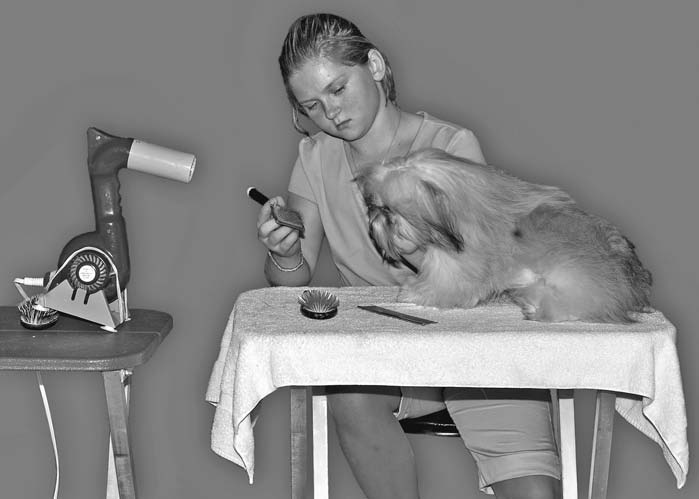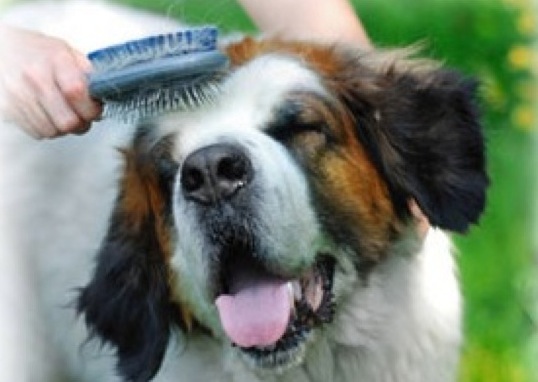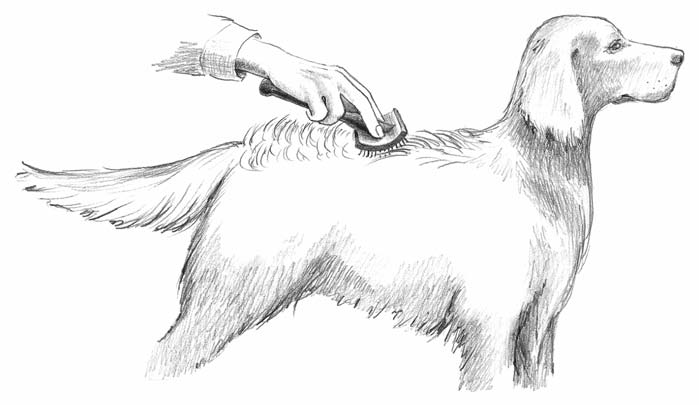Good grooming is a part of caring for your dog, but most of what you do is just maintenance work — that is, just keeping your dog clean and healthy. If you start with a clean dog and maintain a clean and healthy coat, you prevent headaches and disasters later on.
Brushing and Combing Basics
Beyond pulling hairs: Making the experience pleasant
Tip
Here are a few tricks to brushing and combing your dog:
– Start young. When your dog is a puppy, get her used to the procedure. In many cases, dogs love the attention, and you’ll enjoy working on her. However, even if you do start early, some dogs never quite take to grooming entirely. In many instances, you may have to work through some bad behaviors, and in other rare cases, you may need to muzzle or sedate the dog. (See Chapter Mastering Brushing and Bathing Basics for more information about handling a difficult dog.)
– Stick to a routine. Where on your dog you first start brushing, combing, and grooming doesn’t matter, but being consistent when you work does. By following the same routine every time you groom your dog, you won’t forget to do anything, and your dog will be happy there aren’t any surprises.
– Relax with your dog. Taking time to relax — both dog and owner — goes a long way toward calming your dog’s fears. Your dog may get nervous when she senses it’s grooming time, regardless of whether you’re breaking out a grooming table (which I highly recommend using) or simply reaching for a brush and comb. Giving her treats, a good massage (see the “Massaging your dog” sidebar for advice), or just talking to her in a soothing tone helps relieve your dog’s tension before and during a brushing session.
Warning!
If you use a grooming table to groom your dog, never leave her unattended. She can hurt herself jumping off or even strangle herself if she’s hooked into a noose.
– Brush your dog after she’s exercised — when she’s a little bit tired. She’ll be calmer.
– Never hurry, and always be gentle whenever possible. One bad experience can be traumatic and turn your dog off grooming entirely.
– Use the right tools. The right tools make the job not only easier but also less stressful and less painful. Use the wrong tools and you’re likely to pull on your dog’s hairs — ouch! Chapter Training Your Dog for Grooming introduces you to common grooming tools, and the section that follows suggests specific brushes and combs to use when grooming each type of dog.
Massaging your dogMassaging your dog may sound a little odd, but it’s a great way to bond with him and get him to relax. If your dog has never been massaged, he may find it a little strange at first. The first goal when massaging your dog is to get him to relax. Start with gentle stroking movements in areas where he’s normally accustomed to being petted. Don’t touch areas that your dog isn’t quite comfortable with you touching, and don’t use a lot of pressure until your dog gets used to it. Pick up a copy of How to Massage Your Dog by Jane Buckle (Wiley, 1995) or Dog Massage by Maryjean Ballner (St. Martin’s Press, 2001) for the basics of massaging your dog. |
Gathering the tools you need
Tip
If you live in a flea-prone area, make sure that you have a flea comb handy, especially during flea season. (Flea season often begins in spring. If you live in the U.S., www.nofleas.com/Flea-Index.aspcan give you a general idea of when to be especially on guard.)
– An undercoat rake or long comb: To remove the loose undercoat hairs. Some groomers prefer using wide-toothed combs first and then changing to progressively narrower or finer-toothed ones. This strategy is good whenever your dog has really snarly hair. However, if you’re simply maintaining your dog’s coat, you can choose to go over her with a fine-or medium-toothed comb and then a slicker brush.
– Detangler solution and a mat splitter or mat rake: For tangles and mats (electric clippers can be used in extreme cases).
– A shedding tool: For removing the soft undercoat when the dog is blowing coat (shedding profusely).
– A slicker brush: For removing dead hair and stimulating the skin and coat.
– A Zoom Groom or short curry brush: For removing dead hair and polishing the coat.
– A short-toothed comb: For removing dead hair and getting through any tangles.
– A slicker brush: For removing dead hair and stimulating the skin and coat.
Brushing up on basic techniques
Remember
Regardless of the method of brushing and combing you use, you need to brush all the hair and not just the top coat. That means getting down to the skin and brushing upward.
Dealing with the dreaded mat
Because brushing or combing out mats and tangles can cause any dog a great deal of discomfort, don’t keep pulling on them after you find them. Instead, follow these instructions to gently remove tangles and mats:
Work from the outside of the mat (where the hair isn’t tangled) and slowly untangle the hair. Hold the base of the mat (closest to your dog’s skin) as you work to avoid pulling your dog’s skin.
Mat rakes are equipped with sharp teeth that work at cutting through the mat. You use the mat rake the same way you would a comb but simply rake along the lay of the hair. The teeth will cut through the mat.
Start by splitting the mat of hair in horizontal or vertical strips and then using either a mat rake or a comb to tackle those smaller pieces individually. Watch to make sure no skin is pulled up into the mat as you work.
Be careful when using mat rakes or mat splitters. They’re quite sharp and can cause cuts if used improperly.
Be aware that this step should be considered as a last resort and that it can leave a bare patch that will ruin a show coat until it can grow out again.
Short of that, you can also ask a professional groomer or veterinarian to help you get rid of the mat.
Heading down the right grooming path
Tip
If you find mats or tangles around your dog’s face, don’t spray them with detangler solution, because you risk getting some in your dog’s eyes. Instead, dip a washcloth into the detangler solution, gently rub it into the hair, and then gently comb out the tangle, starting from the bottom of the hair. If the mat is really serious — yes, they sometimes have minds of their own — use an electric clipper with a guarded blade to clip out the mat while also guarding your dog’s face and skin (and keeping her reassured and still) with your other hand.
Warning!
Never use scissors to cut out a mat or a knot, because you can seriously injure your dog, even if you are careful about it. If you don’t have grooming clippers, ask a vet or a professional groomer to remove the mat for you. Most are happy to remove the mat or knot at little or no charge.
Smoothing the ruff-les on the nape of your dog’s neck
The neck and ruff areas of your dog’s coat (see Chapter Inside and Out: What Affects a Dog’s Coat and Grooming for more about your dog’s anatomy and appearance) may also be sensitive, so start brushing them with a soft slicker. Brush backward against the lay of the hair (if appropriate — otherwise, brush with the grain). If your dog is shedding, the slicker may fill up quickly. You can use the comb to dislodge the hair from the slicker and deposit the hair in the trash. If your dog has a ruff (the longer, thicker fur around the neck, shoulders, and chest), pay particular attention to it; you need to use a comb or undercoat rake whenever your dog has a long or thick double coat in those areas. Comb through the hair you just brushed before brushing it back the way it should lay.
Brushing and trimming feathered forelegs
Belly-rubbin’ for laughs
Warning!
Don’t pull on any mats on your dog’s sensitive underbelly, and don’t use a mat rake, because one slip can cause problems in these sensitive regions. If you find any mats, take your dog to your vet or a professional groomer who can use electric clippers to carefully remove them.
Sidewinding and backing up
No butts about it
Handling those hind legs
Tweaking that dratted tail
Shedding timeSome double-coated breeds shed profusely once or twice a year. Others shed year-round. If your dog has little tufts of hair that look like pieces of cotton candy scattered throughout his coat, he’s blowing coat, or shedding. You can pluck these tufts of hair out, but most dogs find that annoying. A better solution is to use a shedding blade or an undercoat rake. The shedding blade looks like something you’d use on a horse. It’s a flexible piece of steel with little saw-like teeth that catch the hairs. You can operate the blade in a one-handed U-shaped configuration, or you can keep the blade straight and use two hands. The undercoat rake is a rake with either long sets of teeth to pull the dead hair out or a dual set of teeth that work both the undercoat and top coat. Be forewarned that shedding blades need to be used carefully on thin-coated dogs because the blades can scratch the skin. However, if you own a thick-coated dog, you’re not likely to have this problem. |
Getting pesky fleas to flee!During flea season, which varies from one region to the next, you’ll be using a flea comb in addition to the other grooming implements. After you brush out your dog’s coat, you want to go over her again with a flea comb. At one time, I would have recommended that you use old-fashioned flea control substances such as flea dips and powders while grooming, but no longer! Unless you have an extremely bad flea problem (and even then, the following recommendations hold true), you need to talk with your veterinarian about putting your dog on a systemic flea-control product, which is what the name implies — a flea-control product that’s distributed throughout your dog’s system either in topical (spot-on) form or pill form. The topical products are usually applied between your dog’s shoulder blades and at the base of her tail; you feed products in pill form to your dog. These systemics have rendered other flea-control substances virtually obsolete, except when a dog exhibits undesirable side effects from using systemics. Ask your veterinarian what’s right for your dog. When using any systemic, read the directions thoroughly and follow them carefully. Otherwise, the product may be ineffective. For example, some topical systemics can be ineffective if you wet your dog shortly after you apply them. Use common sense, and if you’re not sure, ask your vet. Also, dosages and the amount of time the systemic is effective vary, so always have a clear understanding of the product you’re using. These flea products likewise often control ticks. Talk to your vet for other possible tick-control solutions as needed. See Chapter Grooming Emergencies: Knowing Doggie First Aid for more information concerning ticks. |
Rub-A-Dub-Dub: Washing Your Dog
Just (rubber) ducky: Making bath time a pleasant experience
Tip
Here are a few tricks that can help you smooth over those rough spots when bathing your dog:
– Start young. Get your dog used to bathing at an early age, when he’s just a pup. Like with brushing and combing, experience is key to preventing bad bath-time behavior. In many instances, you may have to work through the bad behavior. In fact, in some rare cases, you may have to muzzle or sedate the dog. Sound familiar? It is; I say the same thing about brushing and combing.
– Use the right tub, and give your dog easy access. If you’re using your bathtub, putting your dog in it may be as easy as walking him in. With a groomer’s tub, you may have to use a ramp or stairs to walk a big dog into it, especially if you have a bad back (or if you have a good back and don’t want to have a bad back). Use the sink only for small or toy-sized dogs. Don’t use the shower for any dog.
Although you may be tempted to use an outdoor hose for bathing, resist the temptation. It isn’t ideal because the water is usually too cold, and the dog will get dirty all over again from being outside.
– Keep your dog in one place in the tub. Most dogs don’t like to stay still in the tub, so you may want to use a special tub or bathing noose that attaches to the tub to keep him in place (see Chapter Training Your Dog for Grooming).
As is true of the nooses used on grooming tables, you should never leave a dog restrained by a tub noose alone.
– Don’t hurry, and be gentle whenever possible. One bad experience can be traumatic.
– Make bathing as comfortable as possible. To prevent a painful experience, gently put some cotton balls in your dog’s ears — don’t shove them into the aural canal at the base of the ear, mind you. The cotton balls merely help keep water out of your dog’s inner ears. You can also protect your dog’s eyes by applying an optic ointment before bathing him.
Gathering the tools you need
- A pH-balanced shampoo for dogs (and possibly a pH-balanced conditioner for dogs)
- Cotton balls for ears
- Bathing noose (if required)
- Washcloth
- Blow-dryer
- Towels for drying
Tip
You may want to look into the tearless variety of shampoo if you’re not used to bathing dogs.
Scrubbing bubbles
1. To start, place your dog in a tub that’s an appropriate size for your breed of dog.
You may like a hot shower, but that temperature is too high for your pooch!
Some bathtubs nowadays come equipped with sprayer attachments that enable you to focus the flow of the water. They’re great for soaking your dog’s coat and for being gentle around the face.
Tip
While your dog’s wet but before you apply shampoo is as great a time as any to express your dog’s anal sacs, if you were planning to do it as part of your grooming routine (see Chapter Giving Your Dog a Great ’Do: Clipping Basics). Who said dog grooming wasn’t fun . . . ? Yuck!
Soap attracts dirt, and a dog with dried soap in his hair is prone to those dreaded mats.
Using a conditioner that prevents tangles and also keeps the coat from drying out is a good idea for most coat types (see Part III).
With regard to attracting dirt and causing mats, conditioner residues are equally as bad for your dog’s hair as soap residues, so rinse even better than you did in Step 4.
As you squeeze the towels into the coat, look for soapy water. If you find any, go back to rinsing. The next section provides addition advice about drying your dog.
Drying
After you’ve thoroughly rinsed your dog, dry his coat off as thoroughly as possible first using towels. Blot the coat. If you’ve managed not to get wet thus far while bathing your dog, you will get wet at this point, because he will shake off all that excess water and shake some more. After toweling off and allowing for a few shakes, you can move your dog onto the grooming table for a blow-dry and style.
Warning!
Whenever you use a cage dryer, never leave a dog unattended in it. Dogs have overheated and died because the groomers forgot to watch them. Unless you’re planning to open a grooming shop (or you care for several dogs), I suggest you skip the cage dryer and work with the hand-held blow-dryers only.
Tip
When using a blow-dryer, make sure you use one that’s made specifically for dogs (see Figure 5-2) or one that doesn’t use any heat. Hot air from human blow-dryers is much too hot and can hurt your dog’s skin and frazzle the fur. You can use a human hair dryer on the no-heat setting to dry small dogs, but blow-dryers intended for humans don’t have enough power to handle drying a larger, long-haired dog.








